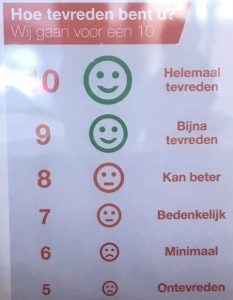Driving results and the KPI game
Singular focus on a limited set of business KPIs can result in processes and behaviours that benefit the reported KPI, but not the business itself. Business leaders should be aware of the risks of driving KPIs versus real life results.
Introduction
Key Performance Indicators or KPIs are used in many businesses. They may go under different names, but most organisations have multiple measurements in place to assess how well their processes are performing. For example, sales measures the number of sales calls and visits, operations the quantities processed or produced and customer service how satisfied customers are.
Recently I came across a nice example of what can happen if improving the KPI itself is made the prime goal and not the process driving it. I went to pick up my son’s car at a local garage. This garage is part of a larger organisation which measures customer satisfaction of its car repair shops.
When KPI’s become a target on their own
Achieving high satisfaction scores is not easy, especially not in the Netherlands where we tend to be somewhat critical. Scoring a 7 out of the maximum 10 is already quite an achievement. To achieve a high satisfaction score, you can either work on providing a better customer experience (the hard way) or tweak the way it is measured (much easier).

This outlet took the easy option and simply adjusted the scale. They ask how satisfied you are and provide an innovative rating system. 10 is ‘very satisfied’. 9 is ‘almost satisfied’. A score of 7 is here defined as ‘questionable’. Scoring below 5 is not even possible. Be sure that the satisfaction scores as measured and communicated by this company are impressive. Whether they reflect the quality of their service is a completely different matter.
This example has of course more to do with marketing than with running a business (‘customers rate our service an 8.9’, which would sound excellent for a below satisfactory service). Nevertheless, we come across overemphasised or simplified KPIs in business quite regularly. Over time this often results in people and processes ‘playing the KPI game’, i.e. finding ways to improve the KPI without necessarily benefiting the business.
How to deal with the KPI trap?
Business leaders should first understand that a KPI is a means and not an end. Make sure that you stay in touch with reality and the people and processes behind the KPI. Next make sure that you do not oversimplify things. It is often better to work with a set of KPI’s in stead of just one. Even better is if you have counteracting KPIs in your set. For example, in sales use revenue and margin to assess the effectiveness of your sales team. Focusing on just revenue will eat away your margin. And finally, maybe you should redefine success every now and then and change some of the KPI’s used. This reduces the chance of the organisation finding the easy way out.
At Business Acceleration we strongly believe that implementing lasting change requires a robust definition of success and matching KPIs. We always include it into our value proposition and sales acceleration programs. How are KPI’s used in your organisation and do you see KPIs being played? What (if) should be done about it?
If you like this post, then you may also be interested in this one about pipelines.


No Comment